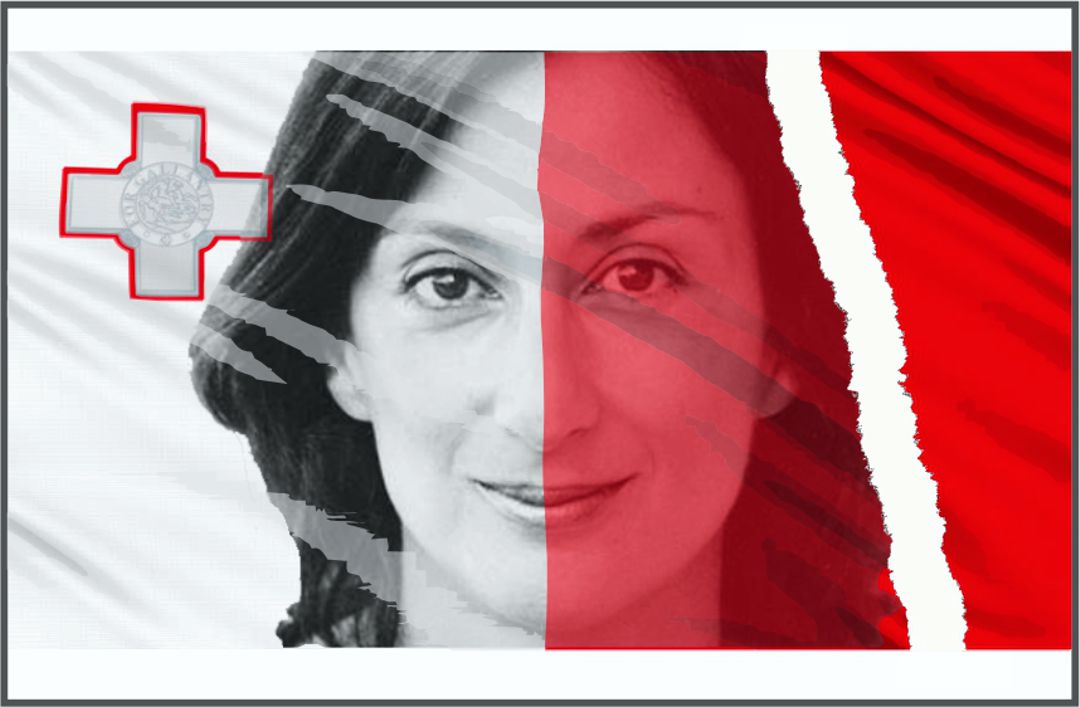
The core issue that underpins the conflict in Great Siege Square is whether the memory of the slain journalist can claim a place on the emblem of nationhood and whether she can be considered as part of the Maltese nation at all. It is the meaning of ‘the nation’ and who deserves to define it that is being contested.
by Raisa Galea
Collage by the IotL Magazine
[dropcap]“[/dropcap]No, they have to clear it up!”, James*, a Valletta resident and a (moderate) Nationalist Party supporter, told me over a beer one November afternoon. He was referring to vocal supporters of Daphne Caruana Galizia who were defending a makeshift memorial to the slain journalist on Great Siege Square in front of the Law Courts from the government’s attempts to remove it.
This conversation took place when the conflict had reached a culminating point. On November 7, 2018 another physical barrier—a line of metal fences—had been erected in front of the memorial site, thus preventing any access to it. For a few weeks, every attempt at restoring the makeshift memorial had been shut down by the state: all commemorative items, from candles to banners were immediately removed by government workers as soon as they had been placed there.
The Great Siege Memorial Strife
By mid October 2018—the first anniversary of the assassination of Daphne Caruana Galizia—the flowers, candles and written tributes left at the foot of the Great Siege Monument to honour the journalist had been taken away at least 17 times.
The strife began to intensify in late August to early September 2018 when acts of vandalism on the memorial became more frequent. Access to the Monument by Antonio Sciortino was sealed off immediately after the celebration commemorating the Great Siege on September 8. The formal explanation for this decision was the need for the restoration of the bronze statues’ granite base. Activist groups Il-Kenniesa, Civil Society Network and Occupy Justice protested the closure and continued placing commemorative items outside the protective screen.
The conflict received contrasting responses locally and overseas. The government’s actions caused outrage internationally: authorities, NGOs and prominent personalities expressed their concern about the repeated destruction of the memorial, absence of a “meaningful result in the investigation beyond arraigning three suspected hitmen” and the state of press freedom in Malta. Activists claimed that the government instigated hatred of its most vociferous late critic and encouraged mob rule. PEN International Executive Director, Carles Torner was reported to have said that “even in dictatorial states like Turkey or Russia, the Government wouldn’t just remove a memorial 20 times.”
Activists claimed that the government instigated hatred of its most vociferous late critic and encouraged mob rule.
On the other hand, support for the activists did not seem widespread among the Maltese population. In some cases, citizens even actively contributed to the clearing of the memorial. What was the reason behind such a reaction from a rather sizable segment of the population? Moreover, one has to ask: why do calls for public inquiry into the assassination find so little support from individuals outside the activists’ groups and are even rebuked by some?
![]()
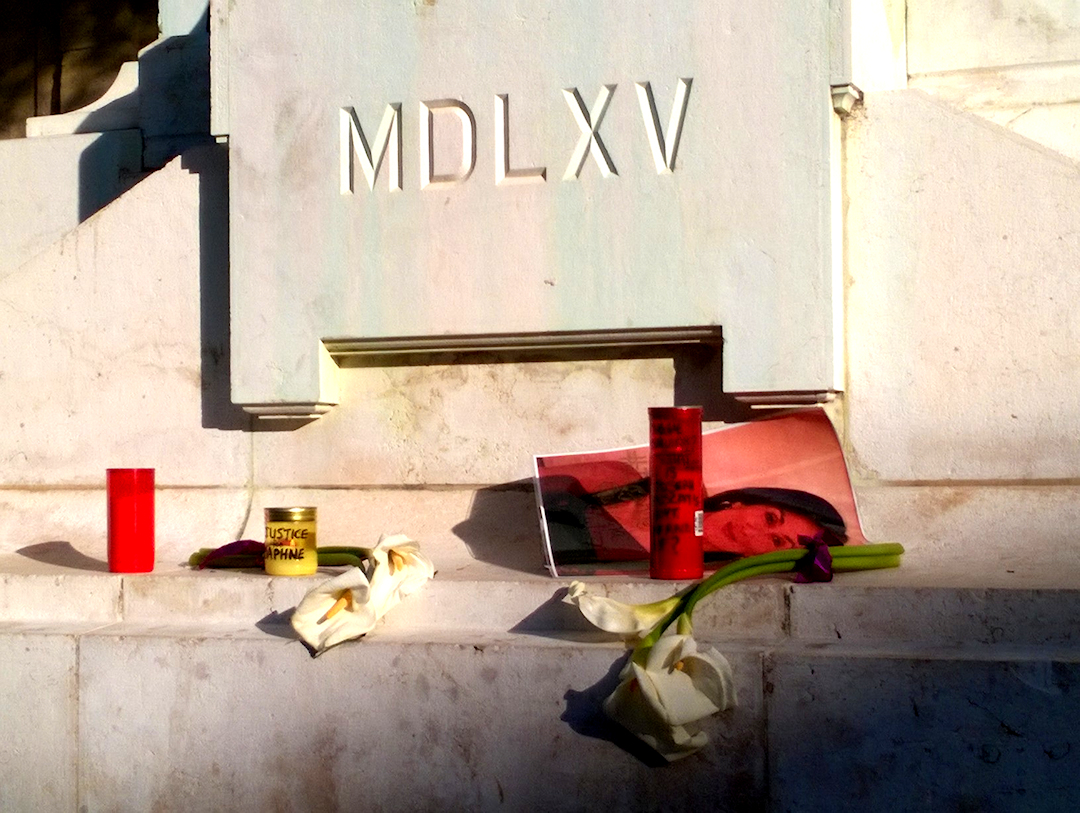
James, with whom I was discussing the events, makes his position clear. He wants the makeshift memorial away from the Square.
Unlike Labour party spokesman Glenn Bedingfield, who can be expected to applaud the government’s decision, James criticises the Labour administration on most issues, except this one. When I remarked that the protestors’ demands for justice were rightful and that they indeed had a right to commemorate Caruana Galizia in that particular location in front of the Law Courts, he gestured disapprovingly. “They should go somewhere else—Sliema, St. Julians, Attard. There are plenty of other places. This is a national monument. They can’t keep it for themselves”.
The Great Siege Monument, a Symbol of National Identity
The Great Siege Monument in front of the Law Courts is an accolade to Maltese nationhood. Sculpted by Antonio Sciortino in 1926 during his stay in Rome, the bronze statue was inaugurated in 1927 by prominent representatives of the state and clergy who delivered their speeches in Italian and Maltese.
Taking into consideration the political climate in Italy in the late 1920s, the rule of the then pro-Italian Nationalist Party whose ranks included a Mussolini-supporting faction and the symbolism behind the three bronze figures—Faith, Fortitude, and Civilization (themselves conservative and nationalism-inducing allusions)—the sculpture conveyed deeply nationalistic connotations at the moment it was unveiled.
The nationalist implications of Sciortino’s sculpture are further intensified by its link to the Great Siege—an event that serves as a tool for the construction of national pride in Malta and is often alluded to by nationalists of various colours in order to advocate for Maltese nationhood as Christian and European and thus opposed to non-European others.
The nationalist implications of Sciortino’s sculpture are further intensified by its link to the Great Siege —an event that serves as a tool for construction of national pride in Malta.
According to philosophy lecturer Michael Grech, the siege of 1565 was probably elevated to the status of a pivotal event in the history of the Maltese islands during the colonial era as a response to colonialism. Prominent Maltese intellectuals argued that, as Europeans, the Maltese did not deserve to be treated like other British colonies, which is why the islands’ links to Europe were emphasised, exaggerated and at times invented.
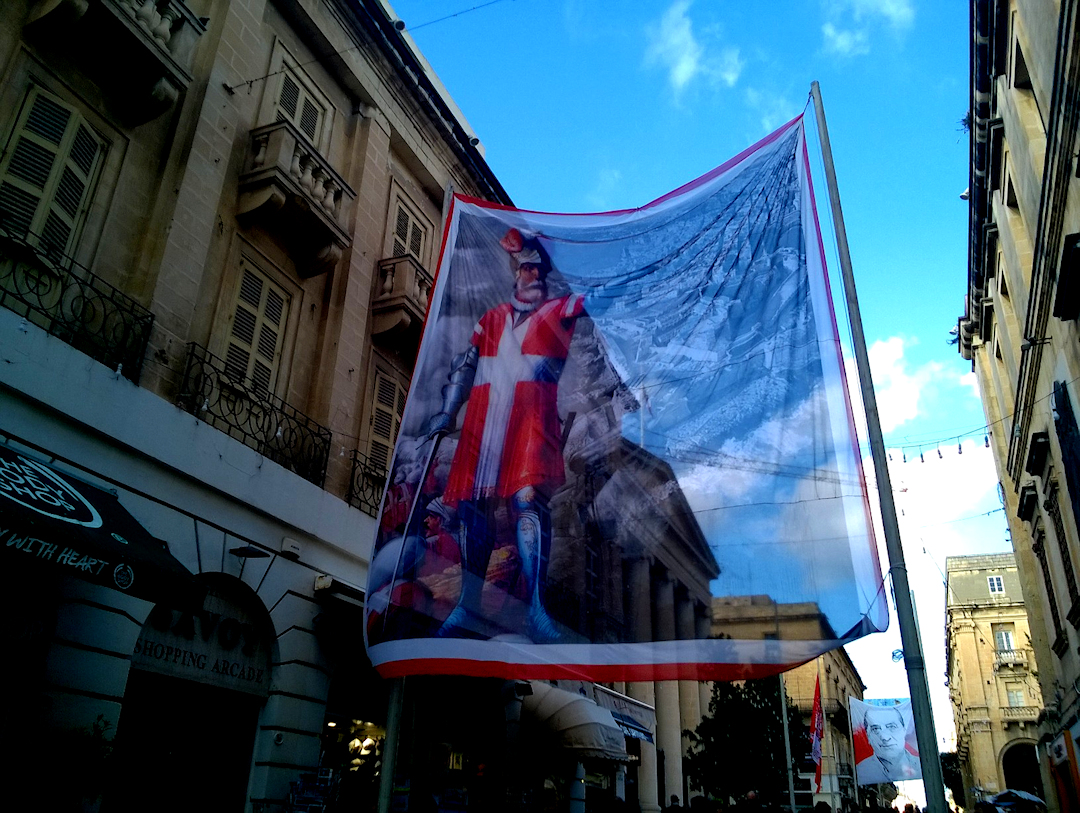
The Great Siege Monument is particularly venerated by far-right groups, including Malta’s chief far-right politician Norman Lowell who stated that “8 September should be Malta’s only National Day” and “once Malta had saved Europe”. He was, of course, referring to September 8, 1565—a date of the decisive victory that ended the Great Siege. However, Victory Day celebrated on September 8 also commemorates the end of French blockade of 1800 and of bombing by Axis powers during World War II—an important aspect that the far-right brigade conveniently ignores.
The strife between supporters and opponents of the late Daphne Caruana Galizia cannot be explained as a rivalry between the Labour Party’s staunch critics and die-hard proponents alone. Since Sciortino’s sculpture is recognised as a national monument by the state and, consequently, by its loyal citizens, its meaning as a symbol of ‘the nation’ as a mythical whole, too, is crystallised in the minds of the majority.
Thus the core issue that underpins the conflict is whether the memory of the slain journalist can claim a place on the emblem of nationhood and whether she can be considered as part of the Maltese nation at all.
Daphne Caruana Galizia as a National Enemy: ‘Authentic Folk’ Nationalism
As Marxist historian Mark Camilleri noted in a casual social media post (written in Maltese), this is not the first time that monuments serve as a political battleground in Malta. He remarked that in the 1960s, the monument of Queen Victoria used to be covered with red paint, which was reapplied every time after it was cleared.
Another example of contested monuments was a bust of Enrico “Nerik” Mizzi, one of the founding fathers of the Maltese nationalist movement, who believed that the task of his political movement was to defend Maltese identity against the threats posed by the teaching of English in school, as well as by cultural and social mingling between locals and the British. The bust was stolen in the mid-1970s and was put back in its place after it was found in the sea at Jews Sally Port.
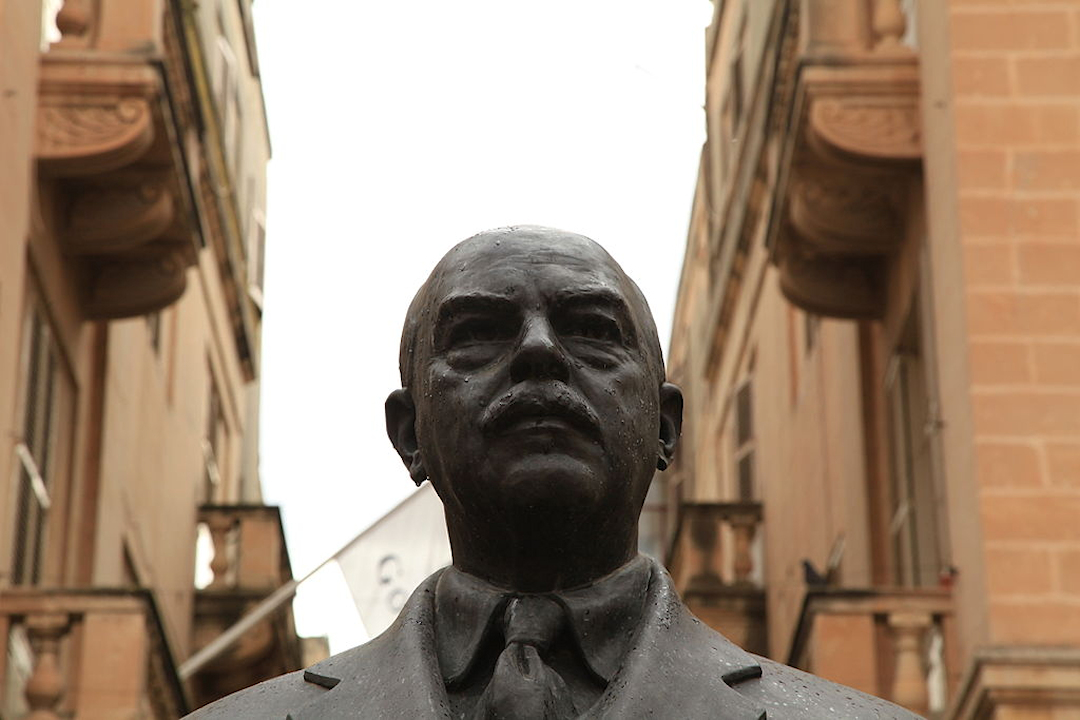
To Camilleri, the makeshift shrine of Daphne Caruana Galizia—just like the monuments to Queen Victoria and Mizzi—can never find the support of the majority of the Maltese population due to the late journalist’s “lifelong devotion to fight the Labour Party and the working class” as well as her unabashed classism. Although I share Camilleri’s perception of the late journalist as averse to lower classes representation in politics and committed to an ‘orderly’ social hierarchy—which were indeed a defining feature of her writing—the acute antipathy that her writing stirred among ordinary—and especially Labour-leaning—locals cannot be explained by their struggle against classism alone.
![]()
Divisions between different social groups in post-colonial Malta are profound and can be visible even to attentive outsiders. Nobody exemplified this discord more conspicuously than Daphne Caruana Galizia.
Not only do the Maltese upper middle class and those from lower classes differ in their lifestyle, consumer preferences and ability to influence public discourse, but also their views on what comprises Maltese identity and the country’s place in international politics belong to opposing camps. In fact, differing views on the country’s place internationally and on national self-determination are intertwined with the social class background of those expressing them.
Divisions between different social groups in post-colonial Malta are profound and can be visible even to attentive outsiders. Nobody exemplified this discord more conspicuously than Daphne Caruana Galizia.
Some Maltese whose perspective Daphne Caruana Galizia’s blog proudly espoused, consider Malta inferior to “more civilised and democratically developed” European societies due to the “inward-looking thinking” of stereotyped Maltese citizens. In other words, these often Anglophone, profoundly Eurocentric representatives of the upper middle class almost assumed the position of the former colonial rulers. They appear to hold that Malta and the Maltese would not be able to become a ‘normal country’ (an epithet for ‘robust institutions and rule of law’) without a continuous supervision from the European Union.
Such views attract forceful hostility from the Maltese-speaking, proud-to-be-Maltese camp whose members are predominantly of lower social standing. They express vocal pride in the achievements of the young independent state and slam criticism of its shortcomings as a deliberate undermining of Malta. This is not to say that the members of this group oppose Eurocentrism as such. Instead, they perceive Malta as an independent state which deserves to be on a par with the rest of Europe and thus should not allow external interference into its seemingly internal affairs.
In the eyes of such ‘authentic’ Maltese nationalism’s proponents, the Caruana Galizia family and the critics of the Labour administration are traitors of the nation. The son of Caruana Galizia, Matthew, is often on the receiving end of nasty attacks from the supporters of this ‘ordinary folk’ nationalism who may or may not be Labourites.
An acquaintance, a Maltese poet and translator, too, argues against the shrine on Great Siege Square for nationalistic reasons. “Daphne was someone who despised the Maltese language and therefore cannot be classified as a Maltese citizen”, he once told me, pointing out why, in his opinion, she does not deserve to be represented at the foot of Sciortino’s sculpture.
In the eyes of such ‘authentic’ Maltese nationalism’s proponents, the Caruana Galizia family and the critics of the Labour administration are traitors of the nation.
Thus, rather than seeing Caruana Galizia as a champion of bourgeois elites—a perspective which would be connected to a class consciousness in the working classes and could eventually lead to a mobilisation against class society in general—many representatives of the lower classes regard her as a national enemy instead. Unsurprisingly, those who view the assassinated journalist as an enemy of the nation would certainly fight tooth and nail against the presence of the makeshift memorial next to the emblem of nationhood.
This troubled perspective co-exists side by side with an equally problematic view which holds the journalist as a national hero in her own right.
Daphne Caruana Galizia as a National Hero: Eurocentric Nationalism
To international observers like Tom Gibson, a murdered journalist “so committed to uncovering corruption” would more likely be venerated as a national hero than vilified. And he is correct in his expectations.
If Caruana Galizia’s views impersonate qualities of a national enemy to numerous Maltese of a lower social standing, others uphold her as “heroic”, a “true patriot” and a watchdog for public mores.
To the representatives of a predominantly Anglophone Eurocentric upper middle class and those who identify with their views, Daphne Caruana Galizia heroically struggled against the moulds of ‘backwards’ Maltese society, thus striving to bring it in line with the other—idealised—Western liberal democracies. “She was fighting to hold Malta and Maltese society to a higher standard, to really get the people in the country to […] respect their country more”, the journalist’s son Paul told The Guardian.
From such a perspective, her gatekeeping aversion to ‘plebs’ willing to ascend to positions of power—whom she often regarded as corrupt by default due to hailing from lower-class circles—signaled a devotion to protecting governance from renegades.
To the representatives of a predominantly Anglophone Eurocentric upper middle class and those who identify with their views, Daphne Caruana Galizia heroically struggled against the moulds of ‘backwards’ Maltese society.
Although the organisers of the monthly vigils clearly stated that Great Siege Square was chosen for its location opposite the Law Courts, and not due to any ideological affinity with the monument itself, the activities nevertheless demonstrate a distinct nationalistic character.
Protestors even attempt to reconcile the aims of their demonstrations with the symbolism of Sciortino’s statue. For instance, one of the protestors, Vicki Ann Cremona, wrote:
The three figures of Civilisation, Faith, and Fortitude represent what we believe in: the true values of a civilised society, the faith that these will triumph in the end, and the strength of a people that is unified in its determination to ensure that justice is done and seen to be done.”
Although the notion of “a people that is unified” is ambiguous, in this specific context it may imply a call for national unity. Another protestor, Martina Caruana, referred to the activists in firmly patriotic terms—as “our country’s shield.”
The group of Caruana Galizia’s supporters regularly underlines her significance to the nation by displaying her name and portraits alongside national regalia. The banner which the civil society groups affixed to the metal fence outside the Great Siege Monument to commemorate the first anniversary of the murder depicted the journalist’s portrait superimposed on the Maltese flag. Although Anglophone in other circumstances, protestors deliver their speeches mostly in Maltese and sing the national anthem at the end of each vigil.
![]()
On a separate note, a perception of Caruana Galizia does not seem to be uniformly negative among far-right nationalists.
Norman Lowell—another representative of pedigreed elites—whose political views the journalist repeatedly criticised and who described her as “a spiteful woman”, staunchly objects to the makeshift monument on a site much revered by him. However, his perspective is not shared by all advocates of far-right ideology. Judging by occasional posts and comments on social media, some proponents of the extreme right (not necessarily connected to Imperium Europa) acknowledge her role in exposing corruption and her effort to ‘civilise’ ‘the nation’.
Lowell goes as far as blaming Maltese cultural inferiority for the lack of progress in the murder investigations. “Malta is a Third World Country in all but name. 80% of the People are Arabic in the sense of Culture. This is due to our Language, primarily—an Arabic Cuqlajta. Six months have passed since this heinous murder—and nothing. The Opposition, or what’s left of it, says not a word—just plays Flowers and Candles” Norman Lowell wrote in April 2018.
It is therefore striking to observe that the vision for Maltese nationalism embraced by Malta’s chief right-wing extremist is not radically opposed to that of the journalist’s supporters. Both groups see Malta as lagging behind idealised ‘civilised’ Europe, yet disagree on what this European civilizational superiority entails.
Conflicting Visions of Nationalism and Justice
The Great Siege tussle is ultimately a battle of two conflicting, but still not entirely incompatible, visions of Maltese nationalism.
The Eurocentric upper middle classes who count on ‘enlightened’ Europe to pull Malta towards progress, and who are backed by international liberal circles, regard Daphne Caruana Galizia as a hero, while proponents of ‘folk’ nationalism denounce her as a national enemy. In other words, both camps advocate their point on the ground of national belonging, memory and identity.
The real protagonist in this particular tussle is, then, not the late journalist but Sciortino’s monument and its accolade of Maltese nationhood. The nationalist connotations embedded in the sculpture themselves set the tone of the battle which diverts from demanding justice for Caruana Galizia and turns it into a contest between opposing groups, each seeking to proclaim itself as the best representative of the nation.
The nationalist connotations embedded in the sculpture themselves set the tone of the battle which diverts from demanding justice for Caruana Galizia and turns it into a contest between opposing groups, each seeking to proclaim itself as the best representative of the nation.
The monument, therefore, contorts the purpose of the monthly vigils. Instead of demanding justice, the focal point shifts towards a spectacle which aims to justify the murdered journalist as part of the Maltese nation. Ultimately, it is the meaning of ‘the nation’ and who deserves to define it that is being contested in Great Siege Square.
As far as justice for the slain journalist is concerned, Daphne Caruana Galizia should not be nationalised, as sociologist Mark Anthony Falzon has already noted. And there are plenty of reasons for that.
Primarily, in the face of justice, a victim’s views on national identity and nationhood are irrelevant. Another reason to steer clear of nationalistic connotations during commemorative events is that they are at odds with the journalist’s vocal opposition to nationalism. Moreover, to turn her into a representative of a seemingly uniform Maltese collective ironically fails to do justice to her own views on deep class divisions within the nation.
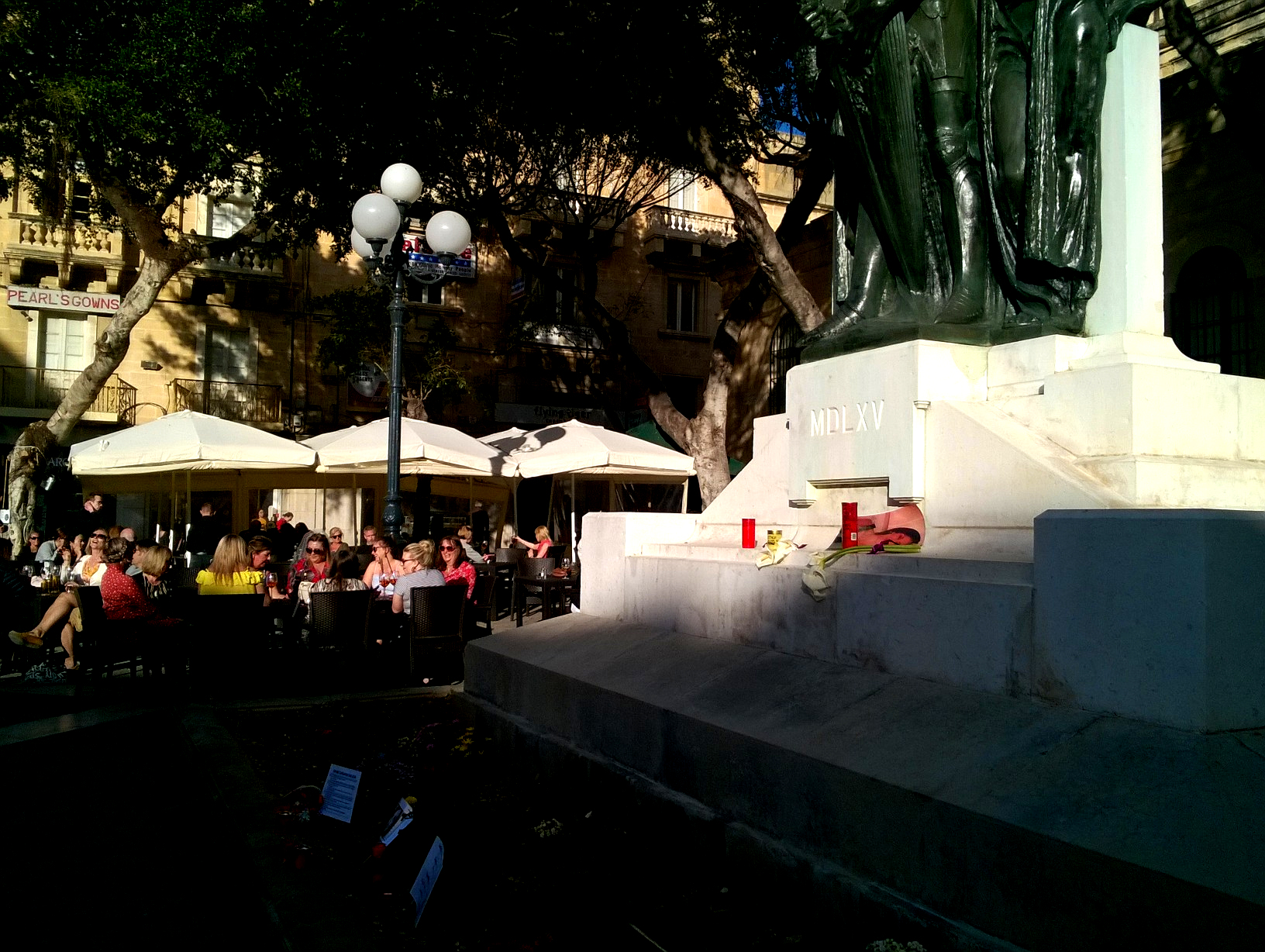
Thus, the tussle in Great Siege Square is a power struggle in which each contestant seeks a chance to establish their views as pertaining to the country as a whole.
While Eurocentric upper middle classes (who already retain support of international liberal circles) have much to gain politically in the case of their victory, same is not true for a working class. A critique of the memory of Daphne Caruana Galizia as discordant with ‘authentic’ national identity prevents them from translating a deep antipathy to the bourgeois hero into an organised movement for their own empowerment and against the capitalist exploitation.
Indeed, it is telling that opponents to the memorial for Caruana Galizia do not seem to object to the overtaking of Great Siege Square by commercial outlets—‘folk’ nationalism seems to go well with capitalism after all.

*name changed
Leave a Reply